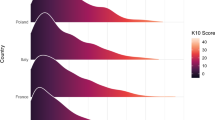Abstract
Background
Kessler's Psychological Distress Scale (K10) is a ten-item measure of psychological distress that has been used in recent epidemiological research and as a screen for mental disorders. Moderate relationships have been reported between the K10 and measures of related constructs, such as diagnoses of mental disorders and associated disability. However, it is unclear whether the validity of the K10 is consistent across important demographic, cultural, and socio-economic groups such as gender and educational history or whether there is evidence of predictive bias or inconsistency across these groups.
Methods
Differential validity or predictive bias in the relationship between K10 scores and disability days, SF12 Mental Component Summary (MCS) scores, and 1-month Composite International Diagnostic Interview (CIDI) diagnoses of the Diagnostic and Statistical Manual of Mental Disorders, Fourth Edition (DSM-IV) Anxiety and Depressive disorders due to gender and completing secondary school were examined using hierarchical linear and logistic regression analyses in the Australian National Survey of Mental Health and Wellbeing data set.
Results
Very small slope and/or intercept biases in the relationship between the K10 and disability days, the SF12 MCS, and 1-month CIDI diagnoses of anxiety and depression were found [effect sizes, the ratio of variance explained to unexplained variance (Cohen's f2), varied from 0.0001 to 0.004].
Conclusion
Gender and educational predictive biases in the relationship between the K10 and disability days, SF12 MCS, and 1-month diagnoses were found to be very small and are unlikely to have any practical impact. This analysis adds to evidence supporting the use of the K10 in epidemiological research.


Similar content being viewed by others
References
American Educational Research Association, American Psychological Association, National Council on Measurement in Education (1999) Standards for educational and psychological testing. American Educational Research Association, Washington, DC
Andrews G, Peters L (1998) The psychometric properties of the Composite International Diagnostic Interview. Soc Psychiatry Psychiatr Epidemiol 33:80–88
Andrews G, Slade T (2001) Interpreting scores on the Kessler Psychological Distress Scale (K10). Aust N Z J Public Health 25(6):494–497
Australian Bureau of Statistics (1998) Information paper: mental health and wellbeing of adults, Australia. Confidentialised unit record file (4329.0). Australian Bureau of Statistics, Canberra
Australian Bureau of Statistics (1999) National Survey of Mental Health and Wellbeing of Adults: Users' Guide. Catalogue number 4327.0. Australian Bureau of Statistics, Canberra, Australia
Australian Bureau of Statistics (2003) Use of the Kessler Psychological Distress Scale in ABS Health Surveys. Information Paper. Cataloge 4817.0.55.001. Australian Bureau of Statistics, Canberra
Cleary TA, Humphreys LG, Kendrick SA, Wesman A (1975) Educational uses of tests with disadvantaged students. Am Psychol 30:15–41
Cohen J, Cohen P, West SG, Aiken LS (2003) Applied multiple regression/correlation analysis for the behavioral sciences, 3rd edn. Erlbaum, Mahwah, NJ
Furukawa TA, Kessler RC, Slade T, Andrews G (2003) The performance of the K6 and K10 screening scales for psychological distress in the Australian National Survey of Mental Health and Well-Being. Psychol Med 33:357–362
Guilford JP (1954) Psychometric Methods, 2nd edn. McGraw-Hill, NY
Hanley JA, McNeil BJ (1983) A method of comparing the areas under receiver operating characteristic curves derived from the same cases. Radiology 148:839–843
Henderson S, Andrews G, Hall W (2000). Australia's mental health: an overview of the general population survey. Aust N Z J Psychiatry. 34: 197–205
Folstein MF, Folstein SE, McHugh PR, (1975) “Mini-mental state”. A practical method for grading the cognitive state of patients for the clinician. J Psychiatr Res 12(3):189–198
Kessler RC, Andrews G, Colpe LJ, Hiripi E, Mroczek DK, Normand, S-LT, Walters EE, Zaslavsky AM (2002) Short screening scales to monitor population prevalences and trends in non-specific psychological distress. Psychol Med 32:959–976
Kessler RC, Barker PR, Colpe LJ, Epstein JF, Gfroerer JC, Hiripi E, Howes MJ, Normand S-LT, Manderscheid RW, Walters EE, Zaslavsky AM (2003) Screening for serious mental illness in the general population. Arch Gen Psychiatry 60(2):184–189
InstitutionalAuthorNameSPSS Inc (2001) Statistical Package for the Social Sciences, version 11.01 SPSS Inc Chicago, IL
von Korff M, Ustun B, Ormel J, Kaplan I, Simon GE (1996) Self-report disability in an international primary care study of psychological illness. J Clin Epidemiol 49:297–303
Ware JE, Kosinski M, Keller SD (1996) A 12-item Short Form health survey. Med Care 34:220–233
Wittchen H-U, Zhao S, Abelson JM, Kessler RC (1996) Reliability and procedural validity of UM-CIDI DSM-III-R phobic disorders. Psychol Med 26:1169–1177
World Health Organization (1997) Composite International Diagnostic Interview. World Health Organization, Division of Mental Health, Geneva
Acknowledgements
The design, development, and execution of the Australian National Survey of Mental Health and Wellbeing was funded by the Australian Commonwealth Department of Health and Family Services. The development of the survey instrument was carried out by Prof. Gavin Andrews, Dr. Lorna Peters, Dr. Tim Slade and others at the WHO Collaborating Centre in Mental Health at St. Vincent's Hospital, Sydney. The design, development, and conduct of the survey was overseen by Profs. Scott Henderson, Gavin Andrews, Wayne Hall, Helen Herrman, Assen Jablensky, and Bob Kosky. Fieldwork and compilation of the data were conducted by the Australian Bureau of Statistics.
Author information
Authors and Affiliations
Corresponding author
Rights and permissions
About this article
Cite this article
Baillie, A.J. Predictive gender and education bias in Kessler's psychological distress Scale (k10). Soc Psychiat Epidemiol 40, 743–748 (2005). https://doi.org/10.1007/s00127-005-0935-9
Accepted:
Published:
Issue Date:
DOI: https://doi.org/10.1007/s00127-005-0935-9




